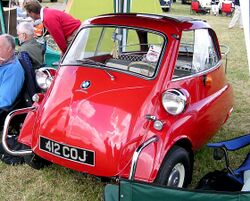Engineering:Bubble car
thumb|Heinkel Kabine
Bubble car is a subjective term used for some small, economical microcars, usually produced in the 1950s and 1960s.[1][2]
Varieties
The Messerschmitt KR175 and KR200, and the FMR Tg500, had aircraft-style bubble canopies, giving rise to the term bubble car to refer to all these post-war microcars. Isettas and others also had a bubble-like appearance.
Bubble cars became popular in Europe at that time as a demand for cheap personal motorised transport emerged and fuel prices were high due in part to the 1956 Suez Crisis. Most of them were three-wheelers, which in many places qualified them for inexpensive taxes and licensing as motorcycles.
Most bubble cars were manufactured in Germany, including by the former German military aircraft manufacturers, Messerschmitt and Heinkel. Automobile and motorcycle manufacturer BMW manufactured the Italian Iso Rivolta Isetta under licence, using an engine from one of their own motorcycles. France also produced large numbers of similar tiny vehicles called voiturettes, but unlike the German makes, these were rarely sold abroad.
The United Kingdom had licence-built right-hand drive versions of the Heinkel Kabine and the Isetta. The British version of the Isetta was built with only one rear wheel instead of the narrow-tracked pair of wheels in the normal Isetta design in order to take advantage of the three-wheel vehicle laws in the United Kingdom. There were also indigenous British three-wheeled microcars, including the Trident from the Peel Engineering Company on the Isle of Man.
Bubble cars were never as popular in North America as they were in Europe; longer road distances and greater post-war prosperity allowed North Americans to continue driving large landyachts in the 1950s. Small automobiles would not become widely popular in America until the 1970s.
The introduction of BMC's Mini in 1959 is often credited with bringing about the demise of the bubble car. The Mini provided four adult seats and more practical long distance transport often at a lower cost, and quickly became one of the most popular cars in its home market, also selling well on export markets.
By the end of the 1960s, there were no bubble cars still in production, as the Mini and other low-priced competitors including the Citroen 2CV, Fiat 500 and Renault 4 continued to increase in popularity. However, bubble cars have seen a small resurgence in recent years, with Myers Motors reintroducing the Corbin Sparrow in 2005.
Examples
- Citroën Prototype C
- FMR Tg500
- Fuldamobil
- Heinkel Kabine
- Isetta
- Messerschmitt KR175
- Messerschmitt KR200
- Peel P50
- Peel Trident
- Trojan 200
See also
References
External links
- The Bubble Car Museum (a bubble car museum in England)
- The Micro Maniacs (the UK's largest multi-make bubblecar and microcar club)
- The Australian Microcar and Scooter Club
nl:Dwergauto ja:バブルカー ru:Мотоколяска




